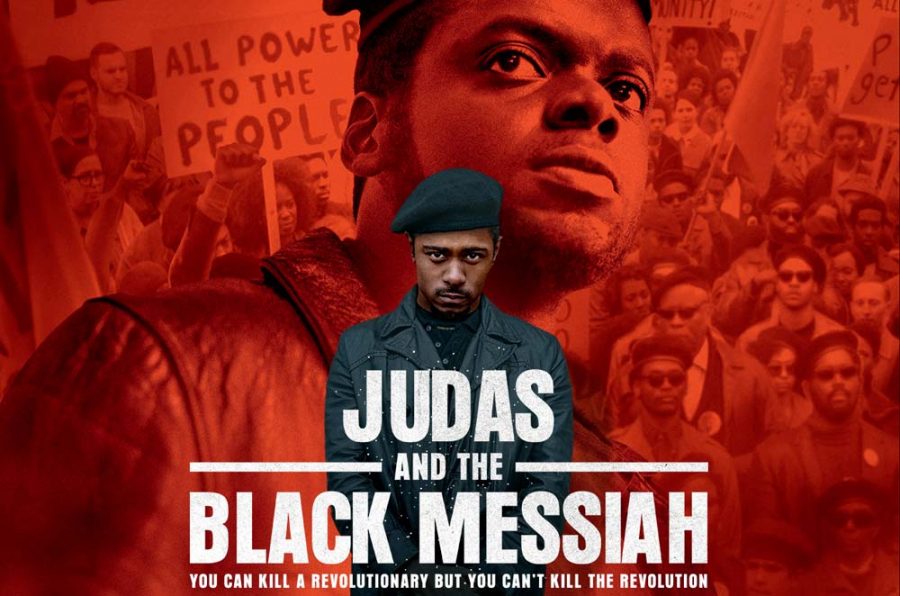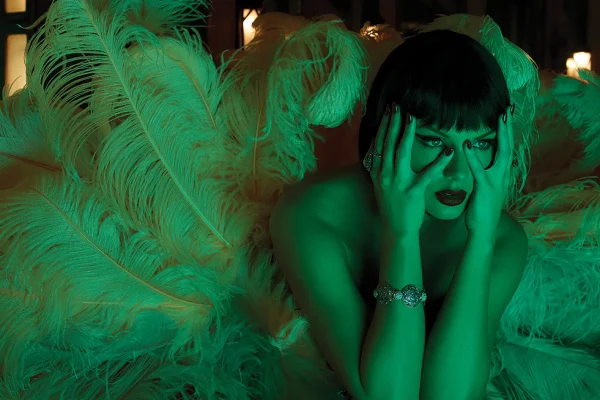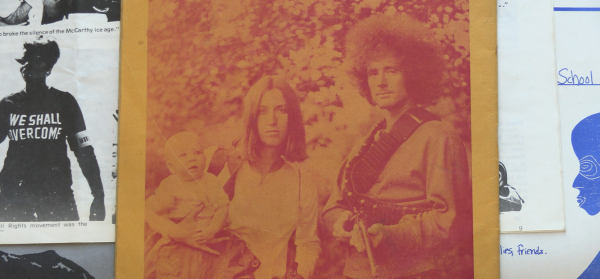“Judas and the Black Messiah” recreates an underlooked part of American history
Director Shaka King’s studio debut leaves audiences wondering why anyone still trusts the FBI
Despite already knowing the fate of Black Panther Party Chairman Fred Hampton, I couldn’t help but feel anxious about each and every masterful line of dialogue when watching “Judas and the Black Messiah.”
This dramatization follows Bill O’Neal played by LaKeith Stanfield, most known for his roles in “Sorry to Bother You” and “Knives Out.” O’Neal is a criminal-turned-FBI informant who must stake out the Illinois Black Panther Party in exchange for his freedom.
At the onset of the movie, O’Neal impersonates an FBI agent to steal a car. O’Neal is arrested and questioned by actual FBI agent Roy Mitchell, played by Jesse Plemons who is most known for his roles in “Breaking Bad” and “Black Mirror.” Mitchell negotiates with O’Neal. His prison sentence will be revoked so long as he joins the Black Panther Party and details their every move.
After joining the party, O’Neal gets promoted as security captain which helps him establish rapport with Chairman Hampton, played by Daniel Kaluuya who is most known for his roles in “Get Out” and “Black Panther.” Hampton’s strong leadership is on full display as he speaks in halls that boom throughout the room and convinces non-black people to join the party. Dialogue between Hampton and O’Neal appears natural but also thought out along with dialogue between other characters. Every line spoken has significance towards the movie’s end and is delivered with pure emotion.
The story of O’Neal and Hampton paralleled the story of Judas and Jesus. Hampton is a savior to those that are discriminated against and deprived of rights. He acts as a leader that people want to follow in a time where all seems hopeless to them. O’Neal’s entire storyline is an act of betrayal for his own self-interest. Hence, the movie is titled “Judas and the Black Messiah.” Without knowing Hampton’s story, societal familiarity with the religious allegory and the historical background of the Black Panther Party make this movie very approachable.
Hampton’s story is an important piece of Black history. At the age of 21, he gave speeches and led rallies all while facing oppression and tackling conflict in the 1960s, when the Black Panther Party was heinously mislabeled as terrorists. Hampton would be murdered in a police raid only a month before his son would be born. “Judas and the Black Messiah” not only gives an accurate retelling of Hampton’s story, but also a retelling that is both thought-provoking and cinematically grand.
With such a stellar ensemble cast, I held high expectations before watching this movie. Director Shaka King utilized every individual actor to the greatest of their acting capabilities. Whenever Hampton enters a room, he carries a booming demeanor that only a true leader could bear. His presence is instantly known. After witnessing Kaluuya’s performance in this movie, the audience might forget he is actually British and not an Illinois native living in the 1960s.
Throughout the duration of the film, the audience is constantly presented with dramatic irony. While they are made well aware of O’Neal’s cooperation with the FBI, Hampton’s lack of awareness plays into the heartbreaking betrayal. When O’Neal is with Mitchell, there is a constant sense of resistance and denial as he leaks information; when O’Neal is with Hampton, the slight smirk on his face transparently reminds viewers of his ulterior motives. This duality of O’Neal could have only been portrayed by Stanfield himself. Stanfield has a wide range of acting abilities, previously showcased as the bizarre and possessed Logan King in “Get Out” and the face-concealing L in Netflix’s “Death Note.” Stanfield’s performance was not merely believable but felt as if the audience were placed in the reality of O’Neal battling between freedom and betrayal.
In 1989, the real-life O’Neal gave his only interview in “Eyes on the Prize II,” a PBS civil rights documentary.
“I don’t think of myself as a hero for what I’ve done,” O’Neal said. “But at the same time, I don’t feel ashamed.”
This quote sums up O’Neal’s character to be neutral in his own eyes although ultimately he isn’t ashamed of his betrayal towards the Black Panther Party. Stanfield’s performance accurately portrays O’Neal’s inner battle between freedom and betrayal, which I would have found difficult to pull off given that O’Neal was only ever shown in a single four-minute video interview. Additionally, throughout the movie, Stanfield is shown in a setting almost identical to the interview done in “Eyes on the Prize II,” giving more commentary on his time in the Black Panther Party. The inclusion of these faux interviews gives a neat recognition to a very important interview that was held. Already seeing the real-life interview beforehand made me think to myself “the writers did their research.” It’s the little details such as this that add up to make the film grand.
Akin to his performance in “Breaking Bad,” Plemons phenomenally portrays the character that audiences love to hate. As a prejudiced FBI agent, Mitchell is manipulative and unhinged. He is defined by his hateful and violent ideologies although he never acts them out directly. Instead, he uses O’Neal as a tool. In a movie teeming with violence, the writers carefully carved an antagonist out of someone who never acts physically violent.
Interactions between Mitchell and O’Neal illustrate how Mitchell’s weapon is not a gun, it is the authority given to him by his FBI badge alongside his prejudice. The dichotomy and dialogue between the two characters represent the divide between black people and the police both in the 1960s and even today. In one scene, O’Neal calls Mitchell on the telephone saying that he is ready to quit. However, Mitchell reminds him of the criminal sentence he would serve if he does not follow through with their deal. O’Neal angrily slams the telephone to hang up. Mitchell comparing the Black Panther Party to the Ku Klux Klan on more than one occasion speaks for itself.

Alongside excellent storytelling comes excellent cinematography. An image that leaves a lasting impression is Mitchell, the perpetrator who wants to disassemble the Black Panther Party. In the crowd of a Black Panther speech, Mitchell acts as the most dominant element. Mitchell sits in focus and all attention is drawn towards his smug look rather than the unification of people. Many similar shots are seen throughout the movie. It never felt like King was restrained with both the dialogue and the camerawork. Dialogue between Hampton and O’Neal appears natural but also thought out along with dialogue between other characters. Every line spoken has significance towards the movie’s end and is delivered with pure emotion.
The movie’s ending sequence is fast-paced, but also horrifying as the audience witnesses the brutal fate of Hampton. Even though I knew what was going to happen, I always had a little bit of hope that it wouldn’t turn out the way it did.
After watching that final scene, I was left heavily impacted by both the story itself and the method of storytelling. Through articles and video essays on Hampton and the Black Panther Party, I was left with deep anger towards the oppressors and sympathy towards the oppressed. King effortlessly recreated that same empathetic frustration with greater depth. Although I already knew the historical details, I never felt the need to look at my phone or check my watch while watching. However, “Judas and the Black Messiah” is an audio and visual piece of art that sets the bar for dramatizations to come and is a stellar way for people to learn about the story of Hampton.
“Judas and the Black Messiah” is now showing in theaters and currently streaming on HBO Max until March 14. Consult CDC Safety Standards before viewing in theaters.
Email Aaron at afacundo@umass.edu or follow him on Twitter @WhatTheFacundo.












